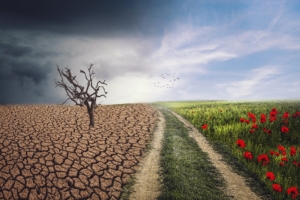
Last year, I read the Sci-fi novel “The Ministry for the Future,” by Kim Stanley Robinson. The novel is about a special organization set up to deal with the political and economical challenges of a global climate crisis in the future. It opens with a terrifying scene in India where the high temperatures and extreme humidity reach the wet-bulb level. That is the level at which the body can no longer sweat and we begin to literally boil to death. In the novel, people stand in disappearing lakes to cool off and there are not enough air conditioners nor enough of a power supply to keep millions of people cool. It sounds pretty extreme and as though it’s either impossible or a crisis we will see far, far into the future. But this summer, temperatures in heavily-populated Central China got as high as 117 degrees F. (or 45 degrees Celsius). “Who cares? Vegas is hotter!” The problem was that this region always has humidity levels that reach into the 90% level. That is not Vegas! This came dangerously close to the wet-bulb level and people moved into bomb-shelters to escape the heat–unable to even sleep. This is not normal.
There’s not a single place I travel to where the local people me that the weather is the same as it always was. Throughout the world storms are more severe, droughts longer, floods harsher, and many places are seeing entire industries (as well as animal and plant life) disappear quickly. In Switzerland, there’s no snow on the Alps this summer and enormous glaciers are completely gone. This has dangerous knock-on effects, such as a shortage of a clean water supply for Switzerland and neighboring countries. Enormous forest fires are no longer a California thing–they are now plaguing the very temperate, cool countries of Germany and France. Rivers throughout Europe are dry or very low. All of it is disrupting agriculture and food supply. It is also straining energy supply at a time when energy costs are set to skyrocket across the world. Extreme floods in Pakistan have displaced 10 million people in that country this summer. Lake Havasu in Arizona is drying up, as is the Western United States’ water supply. The examples are endless, weekly, and from every part of the world.
Much of Sub-Saharan Africa and a huge expanse of Asia from Shanghai all the way across to Iran are in danger of hitting wet bulb temperatures in the very near future. About half of the world lives in this large region that is overwhelmingly very hot and very muggy in normal times. Picture Arizona’s heat with 80% to 90% humidity instead of its more normal 30% or lower humidity. It’s physically unbearable. Even without these extreme temperatures, the world is currently hitting a wall on energy. Wind, solar, and other alternative methods of replacing fossil fuels are nowhere close to being able to meet the current energy demands. Even a quick switch to nuclear would still require lots of water and time to build out.
Yes, there have been examples of climate scientists exaggerating or even making up data. And it is true that the world’s climate has changed before. What is often left out is that those climate changes had a severe impact, particularly if carbon entered the atmosphere at a great rate. Some creatures survived, but it was not pleasant and it changed the world permanently destroying many ecosystems. There are plenty of books and articles that you can find that will talk about climate issues being a hoax. Talking points can be provided. But as farms in the Midwest struggle as never before, as flash floods kill more people in those areas that produce climate skeptics, and as we watch basic things that we’ve taken for granted like rivers, water and lakes disappear or become scarce; the anti-climate science talking points won’t matter. We will soon move on to a world that understands that this is real and that lives in fear of the next summer.
